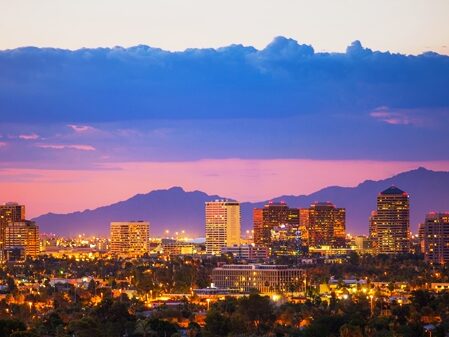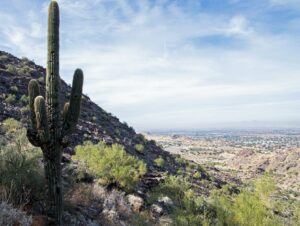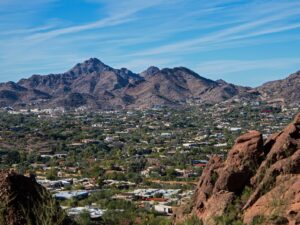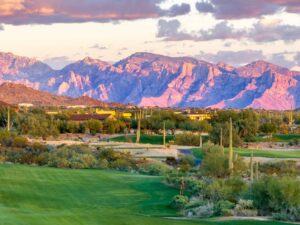Welcome to Phoenix – The Valley of the Sun
Phoenix continues its legacy as one of the fastest‑growing major U.S. cities. As of mid-2024, the city’s population reached ~1,673,000, ranking it the 5th‑largest U.S. city, with growth of about 1% over the previous year, according to ABC15 Arizona in Phoenix (KNXV), Wikipedia. The Phoenix‑Mesa‑Chandler metro area now exceeds 5.18 million residents, growing nearly 85,000 people from 2023 to 2024—largely fueled by international migration.
Why it matters: Sustained migration continues to fuel job creation, retail, and housing demand across Phoenix and Maricopa County.
Dedication to a Livable, Safe City
Phoenix is committed to livability and safety: Local funding programs (e.g., school safety grants) support the expansion of School Resource Officers. Civic collaborations have earned recognition, including All‑America City awards to regional cities, showcasing community-driven problem solving. Phoenix has received the All‑America City Award multiple times, highlighting civic collaboration in addressing local challenges.
Public Transportation & Transit Development
Valley Metro and its light rail system serve the entire Maricopa County: The light rail now stretches over 28 miles, with extensions opening beyond the original 2008 launch. Plans are still in progress to add roughly 30 more miles by 2026–2027. Public transit continues its strategic growth to support a growing metro population.
Phoenix History & Cultural Heritage
Named after the mythical phoenix, the city rose from Hohokam canal-era ruins. Founded in 1868 as Swilling’s Mill and renamed Phoenix by pioneer Darrell Duppa, the city incorporated Named after the mythical phoenix, the city arose from Hohokam canal-era ruins. Founded in 1868 as Swilling’s Mill and renamed Phoenix by pioneer Darrell Duppa, the city incorporated in 1881. Today, Phoenix embodies a rich Native American heritage, featuring reconstructed Pueblo Grande ruins and strong ties to 22 federally recognized tribes in Arizona.in 1881. Today, Phoenix reflects rich Native American heritage, including reconstructed Pueblo Grande ruins and broad representation among 22 federally recognized tribes in Arizona.
Economy & Job Market: Growth Across Sectors
Robust Workforce and Employment
Phoenix continues to be a major hub for job growth, having added 52,400 jobs between 2023 and 2024, representing a 2.2% increase that surpasses national averages. In 2024, total non-farm employment exceeded 2.5 million, with the healthcare sector alone contributing nearly 21,000 jobs. The region enjoys a strong job market, with an unemployment rate hovering around 3.1%, consistently remaining below 4% in most months.
Emerging Industry Clusters
Phoenix is positioning itself as a national hub for advanced manufacturing and clean energy, highlighted by TSMC’s massive chip-fabrication campus, which is projected to create over 70,000 jobs over time. The city is also making strides in tech and cybersecurity, with companies such as ON Semiconductor, Intel, and various local startups driving significant growth. Additionally, sectors like healthcare, education, and construction trades are providing strong hiring pipelines for newcomers.
Education & Innovation
Arizona State University (ASU) is renowned for its commitment to innovation and the development of strong workforce partnerships. This institution plays a pivotal role in shaping the future of its students and the local economy. Alongside ASU, other major universities such as Grand Canyon University and the Thunderbird School of Global Management contribute significantly to the educational landscape of Arizona.
These universities collectively generate a consistent influx of skilled graduates, who are well-equipped to meet the demands of the ever-evolving job market. Their programs not only focus on academic excellence but also emphasize practical experience and collaboration with local industries.
As a result, these educational institutions not only enhance the employability of their graduates but also bolster the local economies by providing businesses with a steady stream of qualified professionals. This synergy between higher education and workforce needs fosters economic growth and innovation within the region.
Metro Population Highlights & Projections
| Scope | 2024 Estimate | Growth Rate |
| Phoenix (city) | 1.673 million | 1% annually |
| Metro area (MSA) | 5.19 million | 1.6% in 2024 |
| 2055 Metro projection | 7.6 million | via continued migration |
Outdoor Lifestyle & Natural Beauty
Phoenix boasts approximately 325 sunny days each year, making it perfect for outdoor activities such as golf, hiking, boating, and cycling. The region features over 200 golf courses, including designs by renowned golfers Palmer and Player, establishing it as a national golf destination. Additionally, nearby lakes like Lake Pleasant and Saguaro Lake offer opportunities for water recreation throughout the year. For those seeking adventure, iconic hikes at Camelback Mountain, Piestewa Peak, and the Desert Botanical Garden provide immediate access to the stunning desert wilderness.
Arts, Dining & Entertainment
Phoenix boasts a vibrant cultural ecosystem featuring over 130 nonprofits and events such as the Scottsdale Arts Festival and Dia de los Muertos. Key cultural institutions like the Phoenix Art Museum, the Heard Museum, and the Arizona Science Center serve as important cultural anchors for the community. The city’s dining scene reflects its diversity, offering everything from Southwestern classics to upscale options like Kai at Wild Horse Pass, which has received AAA Five-Diamond status, alongside local favorites such as Papago Brewing Company. In the heart of the city, Downtown’s Copper Square acts as the social hub, brimming with entertainment, restaurants, shops, and events centered around Chase Field.
Real Estate, Housing & Cost of Living
As of mid-2025, the Phoenix metro housing market has continued to show signs of a slowdown. The median home price has decreased by 1.1% year-over-year, now standing at $445,000. Despite this decline, affordability remains a significant concern, with 47.5% of the average household income required to cover mortgage payments. Citywide, the median home price is approximately $410,000, while the median household income is around $75,969, accompanied by a 16% poverty rate. The rental and condominium markets, however, remain competitive yet accessible across a variety of neighborhoods.
Summary: Why Phoenix Continues to Win Movers
The region is characterized by fast and sustained population and job growth driven by migration. It boasts a broad economic base that includes sectors such as technology, healthcare, and clean energy. Residents enjoy a high quality of life, which features abundant sunshine, scenic desert landscapes, and access to world-class golf and arts. Additionally, the cost of living remains relatively moderate in comparison to coastal metropolitan areas. This makes it a dynamic relocation destination for families, professionals, retirees, and entrepreneurs alike.
If you are planning a move to Phoenix, and don’t know where to start – Order your Free Copy of the Phoenix Relocation Guide!




